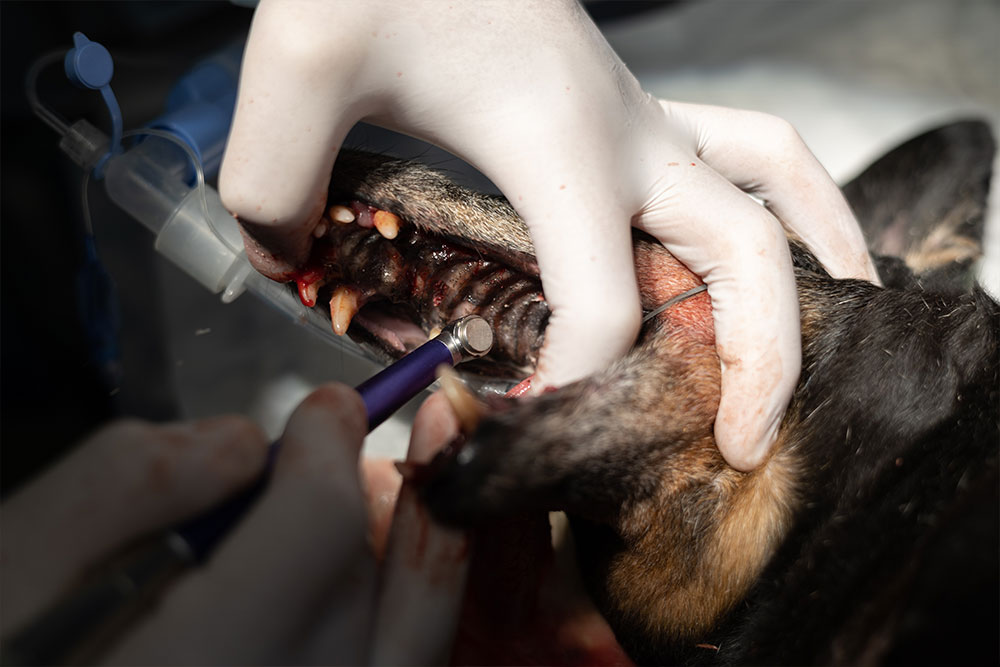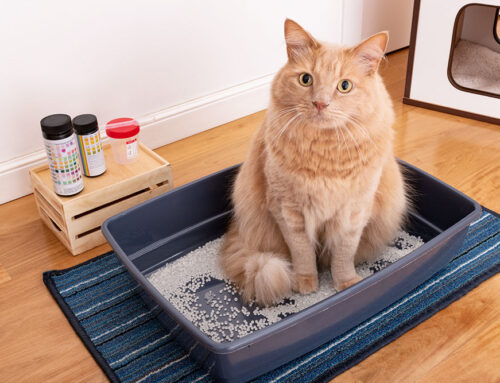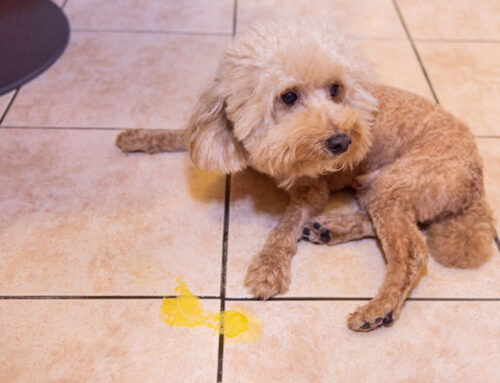Understanding Non-Anesthetic Dental Cleanings for Pets
What Are Non-Anesthetic Dental Cleanings?
Non-anesthetic dental cleanings (NADs) involve cleaning a pet’s teeth without using general anesthesia. Pet owners often choose these procedures due to concerns about anesthesia risks or to avoid the costs of professional veterinary dental care. However, while they may seem convenient, non-anesthetic cleanings have significant drawbacks and risks that pet owners should consider.
What Happens During a Non-Anesthetic Dental Cleaning?
At first glance, an NAD may seem appealing—no anesthesia, no recovery time, and a visibly cleaner smile. But what’s actually happening during the procedure?
- Physical Restraint → To keep a pet still, handlers must physically restrain them. For many pets, this triggers intense stress, fear, and panic.
- Limited Cleaning → The visible surfaces of the teeth are scraped, but plaque and bacteria under the gumline remain untouched—where the real danger lies.
- No Pain Management → If a pet has a loose, infected, or broken tooth, the procedure is not only painful but can also mask underlying disease, delaying necessary treatment.
- Zero Diagnostic Tools → Without X-rays or a thorough oral exam, hidden dental issues go undetected, leading to worsening infections and eventual tooth loss.
On the surface, the teeth may appear whiter, but the most dangerous dental disease happens where you can’t see it—below the gumline.
The Risks of Non-Anesthetic Dental Procedures
Incomplete Plaque and Tartar Removal
Non-anesthetic dental cleanings typically focus only on the visible parts of the teeth. This superficial approach fails to remove plaque and tartar from below the gum line, which is crucial for preventing periodontal disease.
Periodontal disease can progress from gingivitis to periodontitis, damaging the structures that support the teeth. In severe cases, bacteria from dental infections can enter the bloodstream, potentially leading to systemic health issues affecting the heart, liver, and kidneys.
For a thorough dental cleaning that addresses both visible and hidden dental problems, consider Cobb & Co. Dentistry Services.
Stress and Discomfort for Pets
Imagine being in a dentist’s chair—your mouth pried open, sharp tools scraping against your teeth, and the sound of metal echoing in your ears. Now imagine this happening while you’re fully awake, unable to understand what’s going on, and restrained by unfamiliar hands.
For pets undergoing a non-anesthetic dental cleaning (NAD), this is the reality. While these procedures may sound like a gentle, stress-free alternative to anesthetic dental cleanings, the truth is that they fail to provide adequate care and can lead to serious health risks.
Restraining a pet for a non-anesthetic dental cleaning can cause significant stress and discomfort. Unlike anesthetic cleanings, where pets remain comfortable and unaware of the procedure, non-anesthetic cleanings require physical restraint, which can lead to:
- Increased heart rate and stress hormone (cortisol) levels
- Fear-based behavioral changes, including aggression or avoidance of handling
- Negative associations with future veterinary visits
Helping pets feel at ease during veterinary visits is crucial. Learn more about how to reduce pet stress with Behavioral Counseling at Cobb & Co.
Potential for Missed Dental Health Issues
Without anesthesia, veterinarians cannot perform a thorough oral examination. As a result, serious dental conditions may go unnoticed, including:
- Fractured or infected teeth: These often require extractions or root canal therapy.
- Oral tumors: Growths in the mouth can be malignant and require early detection for the best outcome.
- Abscesses and deep infections: These can cause chronic pain and systemic illness if left untreated.
A comprehensive dental exam is essential for detecting these issues early. Regular check-ups are key to your pet’s well-being—learn more on our Cobb & Co. Sick Pet Visits page.
The Importance of Professional Dental Cleanings With Anesthesia
Safety and Efficacy of Anesthetic Dental Cleanings
Anesthetic dental cleanings allow for a pain-free, thorough cleaning and a detailed oral examination. Studies show that modern anesthesia techniques are extremely safe when administered by trained professionals. Anesthesia allows veterinarians to:
- Perform deep cleaning below the gum line
- Take dental X-rays to identify hidden disease
- Extract damaged or infected teeth when necessary
Anesthesia ensures pets remain comfortable while allowing veterinarians to provide the highest level of dental care.
What Happens During a Professional Dental Cleaning?
A professional dental cleaning under anesthesia involves several key steps:
- Pre-Anesthetic Assessment: Veterinarians assess your pet’s overall health with bloodwork and a physical exam to ensure they are a good candidate for anesthesia.
- Anesthetic Monitoring: Your pet is continuously monitored for heart rate, oxygen levels, and blood pressure to maintain their safety.
- Scaling and Polishing: Veterinarians remove plaque and tartar from all tooth surfaces, including below the gum line, where bacteria cause disease.
- Comprehensive Oral Exam: A full evaluation of the teeth, gums, and oral cavity helps detect any abnormalities.
- Post-Care Instructions: After recovery, pet owners receive guidance on home care to maintain dental health.
Addressing Common Concerns About Anesthesia
Modern Veterinary Anesthetic Techniques
Veterinary medicine has advanced significantly, making anesthesia safer than ever. At Cobb & Co. Veterinary Clinic, we use the latest anesthetic protocols and monitoring equipment to ensure your pet’s safety. During every anesthetic procedure, our team carefully tracks:
- Heart rate and rhythm
- Blood pressure
- Oxygen and carbon dioxide levels
- Body temperature
By closely monitoring these vital signs, we ensure that pets remain stable throughout the procedure. Learn more about our protocols on the Cobb & Co. Surgery page.
Pre-Anesthetic Safety Measures
Before anesthesia, we conduct a thorough health screening to tailor an anesthetic plan to each pet’s individual needs. This minimizes risks and ensures the safest possible procedure.
Regular health checks play a critical role in long-term wellness. Visit our Wellness and Preventative Care page for more details.
Making an Informed Decision on Pet Dental Care
Questions to Ask Your Veterinarian
Before scheduling a dental cleaning, discuss the following with your veterinarian:
- How often does my pet need dental cleanings? (This depends on breed, age, and dental health.)
- What are the benefits of anesthetic dental cleanings? (Comprehensive care ensures better long-term health.)
- How can I minimize my pet’s anesthesia risks? (Pre-anesthetic testing and monitoring help ensure safety.)
Choosing the Right Care for Your Pet
Professional dental cleanings are the gold standard for pet dental care, but at-home prevention is just as important. Strategies for maintaining your pet’s oral health include:
- Daily brushing with pet-safe toothpaste
- Providing dental chews and toys that help reduce plaque
- Feeding a vet-approved diet for dental health
Proper nutrition plays a significant role in preventing dental disease. Learn more at our Nutritional Counseling at Cobb & Co. page.
Prioritizing Your Pet’s Dental Health
Choosing professional, anesthetic dental cleanings is crucial for maintaining your pet’s oral and overall health. Discuss any concerns about anesthesia with our veterinarians and schedule a dental consultation to ensure the best care for your pet.
By staying proactive, you can prevent periodontal disease, tooth loss, and painful infections. Early intervention not only improves your pet’s quality of life but also avoids costly emergency treatments.
Frequently Asked Questions
1. How often should my pet receive professional dental cleanings?
Most pets benefit from annual cleanings, but some may require more frequent care, especially small breeds or pets prone to dental disease.
2. What can I do at home to maintain my pet’s dental health?
Regular brushing, dental chews, and a proper diet can significantly improve oral hygiene.
3. What signs indicate a dental emergency in my pet?
Watch for excessive drooling, difficulty eating, bleeding gums, or bad breath—these may signal infection or tooth damage requiring immediate veterinary attention.
Schedule a Dental Consultation Today
Ensuring your pet receives proper dental care is one of the best ways to protect their health and comfort.







Leave A Comment